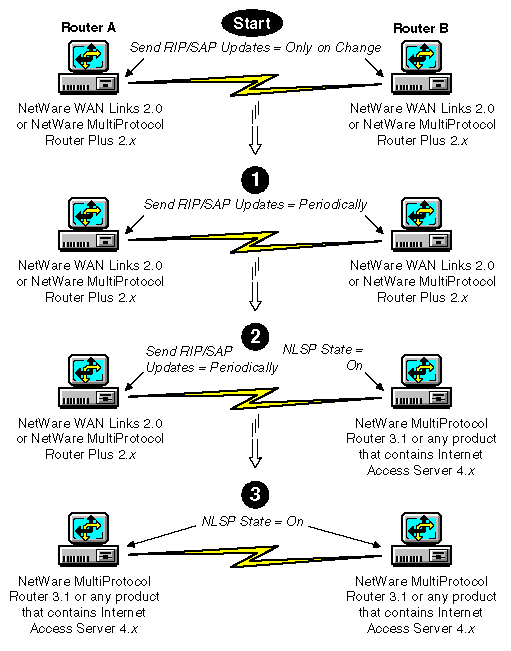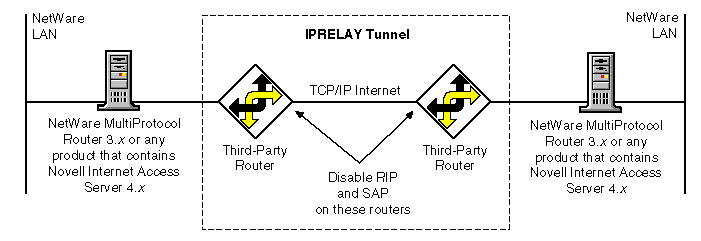
 |
This topic explains how to migrate WAN connections or third-party routers on your internetwork to run---or interoperate with---NLSP software.
This topic includes the following sections:
This section explains how to migrate WAN connections that use any of the following Novell products:
You can either continue using these products or upgrade them to Novell Internet Access Server 4.1.
NOTE: You can upgrade routers on each end of a WAN connection one at a time. Simultaneous upgrades are unnecessary; NLSP runs RIP and SAP automatically until you have upgraded both routers.
This section explains how to migrate LAN or WAN connections that use third-party routers that do not support NLSP but do support Internet Protocol (IP) routing or IPX RIP/SAP routing.
This section explains the choices you have when migrating a WAN connection that uses any of the following Novell products:
How you migrate the connection depends on how you want it to operate:
To configure an on-demand call, you use the on-demand call configuration utility (STATICON). Refer to Setting Up in the IPX documentation for instructions.
When NLSP operates over a WAN connection, it sends a Hello packet periodically to check whether the connection is still active. The traffic generated by NLSP is negligible compared to that generated by RIP and SAP.
To run NLSP over a WAN connection, you install and configure Novell Internet Access Server 4.1 on the routers at each end of the connection. The following steps summarize how to do this:
Install Novell Internet Access Server 4.1 on the routers at each end of the connection.
Start NetWare.
Load NIASCFG, then select the following parameter path:
Select Configure NIAS > Protocols and Routing
Complete the following tasks:
IMPORTANT: These tasks are outlined in greater detail under "Setting Up" for IPX and each WAN protocol. Refer to this documentation for complete instructions if you are unfamiliar with the Novell Internet Access Server Configuration utility (NIASCFG).
Assign a WAN driver to the interface you want to use.
Configure the interface parameters specific to the WAN medium (X.25, for example).
Create a WAN call destination to the router at the other end of the connection.
Select NLSP as the routing protocol.
Configure the IPX protocol parameters.
Bind IPX to the WAN interface; configure the bind parameters for the interface.
Press Esc , then enter
REINITIALIZE SYSTEM
This topic explains how to migrate a router running NetWare WAN Links 2.0, NetWare MultiProtocol Router Plus 2.1, or NetWare MultiProtocol Router Plus 2.11 to interoperate with Novell Internet Access Server 4.1.
These earlier versions of Novell multiprotocol routing software provide a configurable parameter that determines how the router transmits RIP and SAP packets over a WAN connection. This parameter, Send RIP/SAP Updates , has two options:
IMPORTANT: The RIP/SAP functionality NLSP provides does not interoperate with Only on Change.
For a router running NetWare WAN Links 2.0, NetWare MultiProtocol Router Plus 2.1, or NetWare MultiProtocol Router Plus 2.11 to interoperate with Novell Internet Access Server 4.1, you must enable the router to transmit RIP and SAP updates periodically over the WAN connection.
If you want, you can migrate the local router---and the router at the other end of the connection---in stages. Figure 10 summarizes the three-stage process for migrating RIP/SAP routers to NLSP.
Figure 10
Migrating RIP/SAP Routers to NLSP
The following paragraphs explain each stage of migration.
Start shows both routers running an earlier version of Novell multiprotocol routing software, such as NetWare WAN Links 2.0. The Send RIP/SAP Updates parameter is set to Only on Change .
Stage 1 shows the Send RIP/SAP Updates parameter set to Periodically on each router. This ensures that the routers interoperate with other systems running NLSP.
Stage 2 shows Router B upgraded to Novell Internet Access Server 4.1 and running NLSP at its WAN interface. At this stage, NLSP acknowledges periodic RIP and SAP broadcasts from Router A.
Stage 3 shows both routers upgraded to Novell Internet Access Server 4.1 and running NLSP over the connection.
To change the RIP/SAP update mode, or to verify that the active configuration is compatible with NLSP, complete the following steps on the router running the earlier version:
Load INETCFG.
The first selection, LAN and WAN Board Parameters , is already highlighted; just press Enter .
A new screen displays the configured boards and interfaces.
Scroll to a WAN interface, then press Enter .
A new menu displays the configuration parameters for the interface.
Find the Send RIP/SAP Updates parameter.
If the Send RIP/SAP Updates parameter is set to Only on Change , select the field and change it to Periodically .
Press Esc , then select Yes to save the change.
Press Esc again to return to the Internetworking Configuration menu.
Another way to reduce RIP and SAP traffic over a WAN connection is to increase the RIP and SAP periodic update intervals on the routers at each end of the connection. This solution, however, is the least preferable for the following reasons:
NOTE: NetWare 2 and NetWare 3TM software does not allow you to change the RIP and SAP periodic update intervals.
These intervals are measured in 30-second increments. You can set them to any value between 1 (30 seconds) and 10,000 (5,000 minutes, or slightly longer than 83 hours).
IMPORTANT: All routers with the same network number must use the same periodic update interval.
To increase the RIP and SAP periodic update intervals, install Novell Internet Access Server 4.1 on the routers at each end of the connection and then complete the following steps:
Load NIASCFG, then select the following parameter path:
Select Configure NIAS > Protocols and Routing
Select Bindings , then press Enter .
A new screen displays the interfaces currently bound to IPX.
Scroll to a WAN interface, then press Enter .
The Binding IPX to a WAN Interface menu appears.
Select Expert Bind Options , then press Enter .
The Expert WAN Bind Options menu appears.
To increase the RIP periodic update interval:
To increase the SAP periodic update interval:
Press Esc until you return to the Internetworking Configuration menu; when you are prompted, select Yes to save your changes.
Press Esc, then enter
REINITIALIZE SYSTEM
If you are migrating any connections that use third-party routers that do not support NLSP but do support IP routing or IPX RIP/SAP routing, you have three choices:
For more information, refer to Replacing Third-Party Routers with Novell Internet Access Server 4.1.
For more information, refer to Tunneling Through Third-Party IP Routers.
In this case, you allow the routers to operate as they are.
Although this solution offers many features in addition to NLSP routing, it is not always practical or possible because of throughput demands and budget restrictions.
This topic explains how to interoperate with third-party IP routers by setting up an IP tunnel between NetWare systems. Novell provides the following data-link drivers for this purpose:
IPRELAY, a WAN driver that models the tunnel between NetWare systems as a point-to-point WAN connection between peer IP routers
NOTE: IPRELAY is available only with NetWare MultiProtocol RouterTM 3.x software or Novell Internet Access Server 4.1.
IPTUNNEL, a LAN driver that models the tunnel between NetWare systems as a fully connected LAN mesh of peer IP routers
NLSP works with third-party IP routers by means of IPRELAY. IPRELAY encapsulates IPX packets in UDP/IP datagrams that can be forwarded by any IP router.
IPRELAY operates more efficiently than the IPTUNNEL driver provided with NetWare 3.12 and NetWare MultiProtocol Router version 2.x or earlier. To further conserve network bandwidth and reduce the cost of IP encapsulation, Novell Internet Access Server 4.1 uses IPX header compression over the IPRELAY tunnel. Header compression reduces the size of the IPX header to a few bytes.
Figure 11 shows a typical example of a WAN connection that uses third-party IP routers to link two NetWare LANs.
Figure 11
Tunneling Through Third-Party IP Routers with IPRELAY
To configure the IPRELAY tunnel on each NetWare system, complete the following steps:
Install Novell Internet Access Server 4.1 on one of the NetWare systems.
Start NetWare.
Load NIASCFG, then select the following parameter path:
Select Configure NIAS > Protocols and Routing
Complete the following tasks:
IMPORTANT: These tasks are outlined in greater detail in Setting Up in the IP Tunnels for IPX and AppleTalk documentation. Refer to this documentation for complete instructions if you are unfamiliar with NIASCFG.
Enable the TCP/IP protocol and bind IP to the WAN interface you want to use.
The IPX protocol is enabled by default.
Enable the Tunnel IPX Through IP parameter.
NIASCFG assigns the IPRELAY driver automatically to the WAN interface.
Configure the IPRELAY tunnel parameters (Remote Peers , UDP Checksum , and so on).
NIASCFG binds IPX to the WAN interface automatically and creates a WAN call destination to the peer Novell router at the other end of the tunnel.
IPX header compression is enabled automatically on any WAN interface that uses IPRELAY.
Press Esc , then enter
REINITIALIZE SYSTEM
Repeat Steps 1 through 5 on the NetWare system connected to the third-party router at the other end of the tunnel.
After you have configured the tunnel on the NetWare systems, disable RIP and SAP routing on the third-party routers.
You can also tunnel through third-party IP routers with IPTUNNEL, a data-link LAN driver provided with the following Novell products:
NOTE: For compatibility with the IPTUNNEL driver provided with the products in the preceding list, Novell Internet Access Server 4.1 provides IPTUNNEL as well as IPRELAY.
Like IPRELAY, IPTUNNEL encapsulates IPX packets in UDP/IP datagrams that can be forwarded by any IP router. Although IPTUNNEL is less efficient than the newer IPRELAY for large networks, it can still provide a significant reduction in routing traffic over WAN connections.
If you want to use NLSP with IPTUNNEL, each NetWare system at the end points of the tunnel must be running NLSP software, such as IPX Upgrade for NetWare Servers 6.5a, NetWare MultiProtocol Router 3.x, or Novell Internet Access Server 4.x. For example, to exchange IPX/NLSP packets through an IP tunnel between two or more NetWare 3.12 servers, you must complete the following tasks:
Install IPX Upgrade for NetWare Servers 6.5a on each NetWare 3.12 server.
For instructions, refer to the README file .
Configure the IPTUNNEL parameters on each server.
For instructions, refer to your Novell product documentation.
When you bind IPX to the IPTUNNEL driver, set RIP=NO and SAP=NO at each tunnel interface.
The BIND command line should look like this:
BIND IPX IPTUNNEL NET=network_number RIP=NO SAP=NO
 |